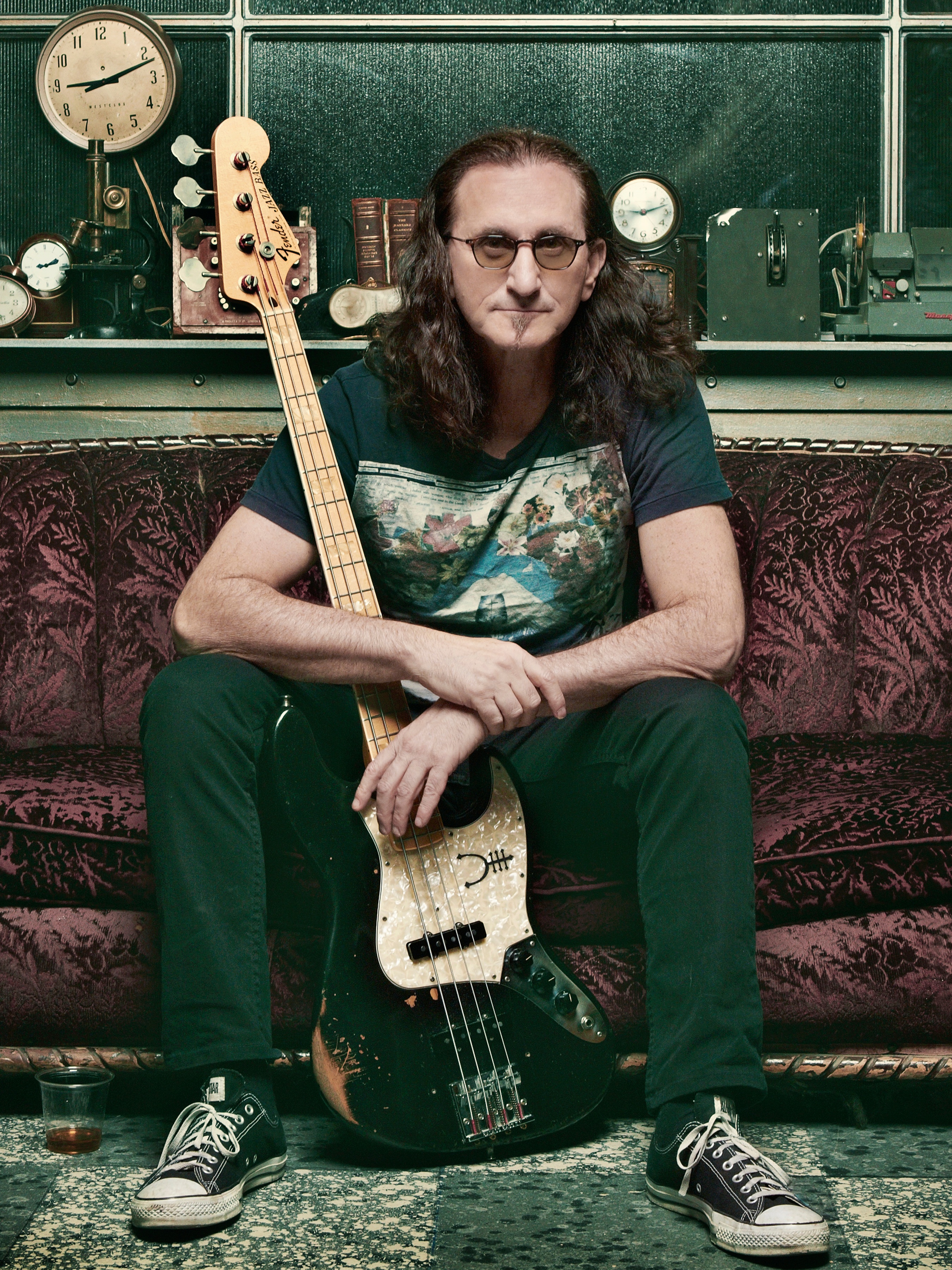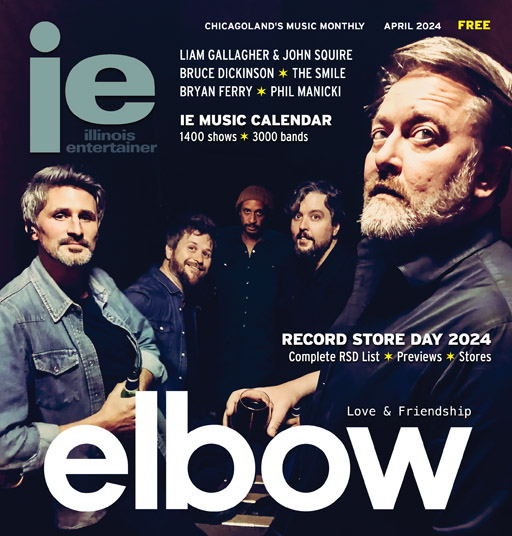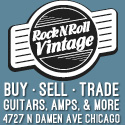Stage Buzz: Geddy Lee – Book Signing at Barnes & Noble, Chicago
Geddy Lee
Feeding The Collector’s Compulsion
By Jeff Elbel
Rush bassist and singer Geddy Lee is known among fans as a man with passions crossing the line into obsession. Whether it’s fine wine or baseball history, Lee doesn’t dabble. He goes full immersion. Following the conclusion of Rush’s R40 tour in the summer of 2015 and drummer Neil Peart’s subsequent retirement, Lee threw himself into a new fixation that had always been right under his fingers: the museum-quality documentation of his carefully-curated collection of vintage bass guitars. He also sought perspective from other prominent players and collectors, including Led Zeppelin’s John Paul Jones, Primus’ Les Claypool, U2’s Adam Clayton, and local hero Jeff Tweedy of Wilco. The resulting tome, Geddy Lee’s Big Beautiful Book of Bass, has emerged as the world’s premiere overview of the electric bass guitar and its history. It’s an entertaining celebration of the instrument, and an educational survey of popular music as well.
On Wednesday, July 17, Lee’s book tour will visit Barnes & Noble near Lincoln Park. Lee will sign the book for fans attending the ticketed event. Lee spoke to IE by phone from home in Canada, less than a week before his visit to Chicago.
IE: It’s probably safe to say that Rush fandom includes an outsized proportion of bass players and bass enthusiasts. That may have provided a solid foundation for the reception of your Big Beautiful Book of Bass, but how important was it to have the book work outside of that community?
GL: I wanted to do justice to the lovers of the instrument and the lovers of vintage instruments first and foremost – without denying interest in my career with Rush, and trying to balance that out. What I found when researching a lot of these instruments was that a story was starting to come together in my mind. It seemed like a different take on the history of popular music from the late 40s or early 50s right through to now, from a perspective of the rumbly-bumbly bottom end. That was an unexpected treat. The more I got excited about what I was discovering, the more I wanted to share it. That’s really what drove the book in a sense and made it end up the way it has.
IE: This book seems to present you in three ways: as an authoritative historian, as an expert practitioner, and as a raving fan celebrating the instrument.
GL: That’s well put, actually (laughs).
IE: If there’s another such book dedicated to the bass and its history, I’m not aware of it.
GL: When I was just starting as a collector, I found it difficult to find enough information in one place. In fact, I couldn’t find any such book, as you just mentioned. You can find bits of information. There’s a book about Gibson. There’s a book about Ampeg. There’s a book about Hofner. All of these books usually have a chapter or two dedicated to the basses. There’s a lot of misinformation floating around the internet, of course, and a lot of anecdotal information. As I was learning about the story of my own instrument, I felt that I had found a hole in the world of books that brought all these things together.
IE: How many basses do you feature in the book? Are they all in your private collection?
GL: There are 250 basses in the book. And yes, I’m sad to admit that they are all in my collection (laughs).
IE: What is the dream bass you’re still hoping to add?
GL: Well, there are a few specific vintage custom color basses that I’m still looking for. I don’t really have a pre-CBS foam green Fender Jazz bass. It’s all about the greens if you ask collectors. There’s a ‘68 Fender Telecaster bass that was done as part of a duo that celebrates the Summer of Love. One was done in literally [pink] paisley wallpaper, and the other was blue floral wallpaper. The blue floral seems to be a real tough one to find, so I’m still looking for that.
IE: You played the pink paisley on the R40 tour, didn’t you?
GL: Yes, I did. And I had the guitar version, which I loaned to Alex [Lifeson] so he would match. He’s a reluctant vintage guy. I have to provide all the best vintage instruments to him to use (laughs). Anyway, there are a few things out there that I’m still looking for.
IE: So, it’s not a Holy Grail hunt. It’s a list.
GL: Yeah, that’s right.
IE: How many basses did you bring to United Center on the R40 tour in 2015 for the set list running backward through time? For comparison, the first time I saw you was at the Rosemont Horizon in 1984 for Grace Under Pressure. How many basses would you have carried then?
GL: In ‘84, I probably had three or four basses maximum on tour with me. On the last tour, I had 27.
IE: Your poor tech!
GL: He lost weight on that tour. He was hopping. And mostly they were vintage basses, with the exception of a few of the ones that I’ve always used. Some of my collector friends were saying, “You’re not going to take those on the road and beat them up, are you?” I said, “Yeah, I am!”
IE: They’ve got to be played.
GL: You gotta play ‘em. They’re living. They need to sing.
IE: Which of those four basses from ‘84 were you still playing for R40, if any?
GL: Grace Under Pressure was my Steinberger period, and that bass didn’t make it out on the last tour. That was a period that I sort of went through and then left behind. At that time, I’m not sure if I was playing the double-necks. Those were probably also resting. So, the only basses I would have had were my trusty Rickenbackers – the ‘73 and ‘77. I don’t remember if we played “Xanadu” in those days. If we did, then the double-necks surely would have been there. I don’t think I’d got into the Wal basses yet, so that wouldn’t have been there. I would have had my space bass along.
IE: I don’t believe I ever saw that one on stage.
GL: That was always lurking backstage without a reason to use.
IE: Please remind me of the name of your tech. I should know.
GL: His name is John “Skully” McIntosh. He curated the collection for me, and he’s my tech. He lives in the shadows, Skully. And proud of it.
IE: But he’s got lots of great toys to play with there in the dark.
GL: Oh, yeah. He was always the proud defender of authenticity. When we would review facts about things I was putting in the book, he was a stickler for making sure that they were actually true. If I couldn’t verify that this was an actual, true thing about this pickup or that pickup, we couldn’t put it in the book.
IE: That type of critical expertise goes well beyond copy editing.
GL: Some of it is controversial stuff. I do step outside of the area of fact from time to time in the book, but I’m very clear to say, “This is my opinion.” There are some assumptions I make based on what I’ve been able to discover through collecting, comparing, and playing. The one great advantage of having a large collection is that you can A-B [compare] things that most people can’t possibly A-B. They’re all there in the same room, and I can plug them in one after the other with the same parameters. I can hear the difference in the pickups that were wound at the Fender factory in ‘63 versus ‘64. So, there are nuances that are experiential. But I always point out when it’s just my opinion.
IE: One of the descriptions that made me laugh was the Ampeg AEB-1. It’s such a cool-looking bass, but kind of a sonic terror. John Doe from X has been through town a couple of times recently, and he brings that thing out for a couple of songs. On its own, the tone is so unwieldy, deficient, and weird – and frankly, just bad. But in the right application, it’s unbeatable.
GL: Yeah. I love those beasts. There are just some things where you have to love the weirdness about them. The guy who owned Ampeg was really not a fan of the world of electrics. He was more interested in replicating the sound of the stand-up bass. He was a classical sort of dude. So, that bass ended up being such an anachronistic thing.
IE: What would you consider the weirdest bass in the book, and how would you use it?
GL: There are many basses that are weird visually, such as the Wandré basses from Italy. I have not been able to find an application for those musically yet. So, they are treated as objet in my house. They’re works of art. And the Ampegs, as we discussed – I love them, but they are difficult to find an application in the kind of music that I do.
I think the strangest ones for me were the Hofner solid basses. That was the biggest surprise for me. I didn’t really even know that Hofner made these solid basses, and so long ago – in the early ‘60s. The focus of every fan that grew up with the Beatles thought of the violin-shaped bass. When I first found this awkward slab-looking bass and plugged it in, it just blew me away how great those pickups sounded. That was probably my big “aha!” moment and made me amass this collection of Hofners – and no one in their right mind should have that many Hofners – but I had to learn everything I could about what was going on there. There’s nobody left at Hofner that knows any of that.
IE: Oral history is gone.
GL: For someone who’s a collector, that’s a challenge. As Joe Bonamassa kindly pointed out to me when he visited one time here – he said, “You’re a different collector than me, because I buy specific things, but you are a completist. You take that attitude of filling all these gaps.” He was right; that is how I go about it. I didn’t know that about myself ‘til he pointed it out. I didn’t know there was a word for it!
IE: The book is massive. You don’t want to drop it on your foot. How long did you spend working on it end-to-end?
GL: From conception to actual production was probably two and a half years, but it was under two years from when we first started shooting. We spent eight months shooting. We built a [photo] studio out of my wife’s art studio in my home. She generously let us use it, assuming that we’d be up there for a month or so. We were eventually greeted with her pointing at the watch going, “Can I get my room back soon?” “Sure, hon, but these five bases just arrived, so we have to check them out.” She was a real trooper.
IE: How did you make it up to her?
GL: Uh, I really haven’t made it up to her yet (laughs), but she knows me, and she understands. Bless her heart; she puts up with me. At the end of the day, we had 30,000 photographs that we whittled down to a mere thousand or so. That was the real challenge, and also the fun of learning how to put a book together.
IE: I wondered whether you might apply this experience toward your compulsions in other areas? You must have been asked whether you’d consider doing a book on your collection of baseballs.
GL: Yeah, my photographer asked me about it weekly, because he really wants to shoot them. I hadn’t really thought about it because I’m just a baseball fan, whereas the bass book seemed connected to my life in a more profound way.
IE: It’s connected to your work. I wouldn’t know whether that would mean you’re less invested in terms of the history of baseball and your collection than you would be in basses. It’s just not your job.
GL: That’s true. It’s a good point. It certainly would be an interesting take, but there are so many books about the history of baseball. I don’t know if I’d be adding anything fresh enough.
IE: You wouldn’t be filling a hole in the world of books.
GL: Yeah, exactly.
IE: How dispersed is your collection of basses? You’ve loaned out portions to different organizations.
GL: Right now, 22 of them are in Calgary at The National Music Centre. They have a nice exhibit there.
IE: Are they a particular set of 22?
GL: When we did a small pop-up at the Rock and Roll Hall of Fame, they only had room for eight basses. Like, what can you say in eight basses? So, we did mostly basses that were related to my career. In Calgary, we’ve broken it up to try to have a bit of a representation for each chapter of the book, to try to get a bit of the historical scope and the eccentric range.
IE: The interviews in the book are captivating. I wouldn’t want to put one above the other, but I wondered who was the luckiest or trickiest to arrange? Who made you think, “Wow, I wasn’t sure that was going to work out?”
GL: Bill Wyman, without question, because he’s a difficult chap to nail down. He’s a fascinating person, and he has so many interests. He’s a man after my own heart in this sense. He’s written nine books, including a mystery novel. He’s invented his own metal detector because he has very small hands, you see. (Adopts Wyman’s cockney accent) “Look at my hands; they’re very small.”
He’s an amateur archaeologist. He’s found important relics around his own home. I think he’s in Sussex. He’s written a book about these, and he has a relationship with the British Museum where these things end up. He’s a butterfly photographer. He has been the historian for the Rolling Stones. He invented the first fretless electric bass.
Now, my other friend Alan Rogan [the Who’s longtime guitar tech], who just sadly passed away a couple of days ago, told me, “Well, you know why it has no frets? Because he couldn’t figure out how to put them back in!”
Anyway, Bill was an unusual character. He’s the only one where we met in a restaurant as opposed to my home or one of their homes. And he really didn’t want to talk about basses. The subject really is not very interesting to him. He was the first interview I had done, too, as a raw rookie dealing with a real character.
He’s got a great sense of humor. He’s a cockney. He’s irreverent, and he’s not afraid to poke back at you, so he’s great fun to sit and have lunch with. It was it ended up being a three-hour lunch in Chelsea. I had to keep trying to bring him back to what I wanted him to talk about, but honestly, I could have listened to his stories for days.
IE: I have my guesses, but who would have been your top picks if they had still been with us?
GL: To have opportunity to talk to John Entwistle or Jack Bruce or Chris Squire … my God, that would have just been so fulfilling. There are so many great bass players I could have talked to and could have included, but to me, it wasn’t enough just to be a great bass player. It had to have some relevance to what I was trying to do with the book, which is about collecting and about vintage instruments.
IE: You mentioned the Wandré earlier. I don’t think I’ve seen you play fretless unless you brought out the fretless for “Malignant Narcissism.” Do you play double bass?
GL: No, I don’t play double bass. My friends that do play it say I should keep at it (laughs). I do play fretless from time to time. I did play fretless on “Malignant Narcissism” on that [Snakes & Arrows] tour, and that was fun. I don’t consider myself a great fretless player, but I can find my way around the neck. But double bass is really a different beast, especially for the genre of music I play. Les Claypool plays it. He makes good noises out of anything he picks up – or as he would put it, any four-stringed piece of furniture he picks up, he can make noise out of it.
IE: When did your collector’s compulsion begin? What did you collect as a kid? Baseball cards?
GL: When I was really young, I was a stamp guy. That’s a sign of the über-nerd.
IE: Do you still have your collection, or did your mom throw it out?
GL: No, I have them somewhere. I sort of inherited a collection that my dad had. For years, I thought he was a stamp guy. Apparently, he just found this old collection in the old country and brought it with him. That set me off down the road where I started a collection with some of the other nerds at my public school.
And then, of course, my next big collection was vinyl when I became a music lover. I still have all my vinyl. I don’t play them, but now I’m feeling like I really want to start playing them again. I love bringing them out.
IE: I keep a record player right on my desk. CDs rarely get played anymore, but the vinyl gets played all the time.
GL: Good for you, I want to do that in the next iteration of my home. There will be a vinyl area.
IE: Was there a live concert experience that was a game changer for you?
GL: I would say seeing the Cream in 1969 was probably that. Actually, I think it was ‘68, at Massey Hall in Toronto. No one wanted to go to that show with me. I went down to it on my own, and it was amazing to me. I got to sit in the balcony and overlook Jack Bruce winding his way through his parts. The other guys were good too, but it was Jack Bruce who kept me spellbound. He was quite an amazing player – talk about a guy who could play anything.
John Paul Jones told a story; I can’t remember if I included it in his interview, but he was going into a studio to do a session, and Jack Bruce was coming out with his double bass. John was saying, “You’re still using that thing?” And Jack said, “Yeah, yeah, I’ll use it forever.” But obviously, that changed rather quickly.
You know, the first bass he used in Cream was a six-string Fender. He used Danelectros. For a while, he used just fretless. So, he could play anything.
One nerdy fact that didn’t make it into the book was this obsession that Skully and I had with the super-early [Epiphone] EB-3s. The really early EB-3s didn’t have that Varitone dial. There was just a switch. I would pore over Jack Bruce photographs looking for a clear one that showed the switch, because he always used to say, “I only had one EB-3.” But yet, he did have more than one EB-3.
So, I wrote a whole thing about that. In the end, when we were tight for pages, I figured that was one we could let go because we weren’t really proving anything. It was just a moment’s obsession with Jack and his EB-3.
IE: Are you happy to be remembered as a top bassist, when you also pushed to develop skills as a songwriter, singer, producer, guitarist, keyboardist, et cetera? Does any part of you get jealous of the attention the bassist part gets?
GL: No. I’m really fine with that. I’ve always considered myself a bassist first, and that’s really my first love.
IE: I’m sure people constantly remind you of dates these days. It’s been four years since the R40 tour visited Chicago. There have been whispers since then about new music from Rush, or maybe from you and Alex, perhaps without touring. Is any of that on the table?
GL: Not at this point, no.
IE: How about a follow-up to My Favorite Headache?
GL: That’s possible. I don’t know. I do have some ideas, but I haven’t put any action into them. I haven’t discussed anything with Alex in quite some time. We talk all the time, but we haven’t talked about work. You know, I was in a very intense job for over 40 years, and you don’t just walk out of that into something else. This book has been a marvelous escape and education, and in a sense, edified me in ways I never thought it would. Eventually, I’m sure I will start making some noise downstairs.
IE: Do you sock away songs and musical ideas here and there?
GL: I store riffs for a rainy day. Eventually, the rainy day will come, I think. We’ll see if they’re any damn good.
Geddy Lee book signing information:
Wednesday, July 17, 2019
6:30 PM CDT (no line-up before 4PM)
Barnes & Noble
1441 West Webster Avenue
Chicago, IL 60614
Tickets: https://tinyurl.com/GeddyBookCHI
Category: Stage Buzz











Mr. Jeff Elbel,
Thanks for taking such time to thoroughly think through questions to a Master Entertainer as Mr. Getty Lee. I was embraced in the story and amazed how well informed you were on his life and the bass for that matter! Your words to Mr. Lee were as if you were life long friends. Thanks so much for your talents in writing up such a wonderful story and sharing great memories. I was at Rush’s R40 tour in the summer of 2015! It was my most memorable concert ever. Thanks again John Monino loyal Rush Fan Forever!
Jeff—this interview was about the most satisfying, intelligent, thought provoking, and well-informed I’ve read in a long time. To me, the best part of a great interview are the questions posited by the interviewer. We have all read countless interviews where the questions were so uninformed. There wasn’t a single question I read that wasn’t a perfect platform for the artist and the reader to marvel at. Just outstanding Jeff, kudos and Bravo!
See you in Chicago Geddy, with family.
Geddy Lee and John Entwistle the two greatest bass players in the history of Rock music
I wish Geddy was doing a signing here in Colorado.
I was there, what a horrible experience! You had to purchase the event? When asked if I could buy the book in…..The Book Store, I was told they didn’t have any, and I couldn’t get in without purchasing the event wristband which was sold out? I wanted to meet my childhood idle and was denied. I went home and seriously cried in disappointment….
Mr. President: Ticket info was listed at the bottom of the interview. With an artist of of Geddy’s stature, hindsight suggests there would be a line to get in, no? -Ed
Check out Ed Stenger’s Rushisaband.com, and you won’t miss another Rush event ever.
Thanks for a great interview. I’m a Rush collector in Michigan. I hope to make a book about collecting Rush memorabilia some day. =)